Page 435 of 576
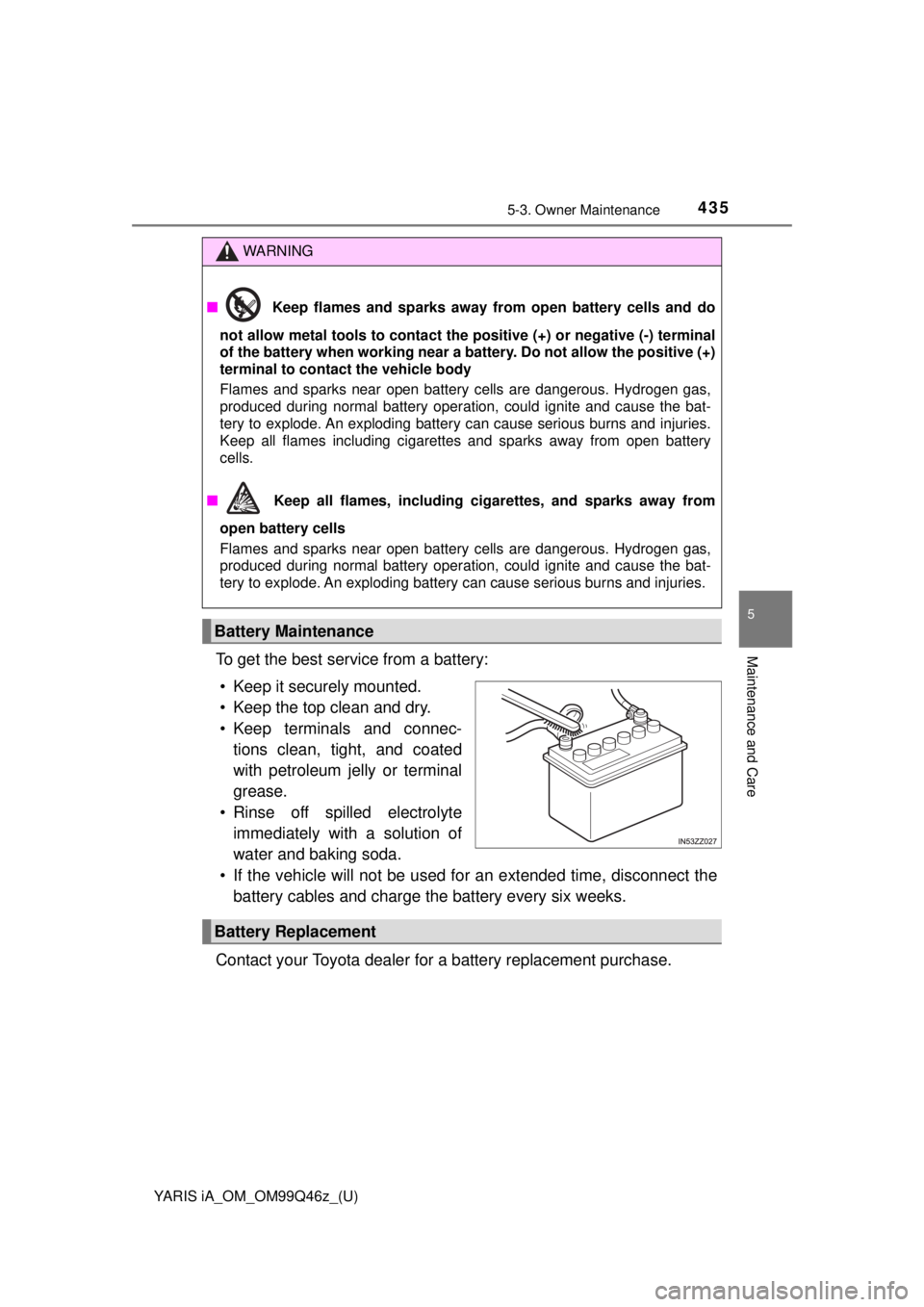
YARIS iA_OM_OM99Q46z_(U)
4355-3. Owner Maintenance
5
Maintenance and CareTo get the best service from a battery:• Keep it securely mounted.
• Keep the top clean and dry.
• Keep terminals and connec- tions clean, tight, and coated
with petroleum jelly or terminal
grease.
• Rinse off spilled electrolyte immediately with a solution of
water and baking soda.
• If the vehicle will not be used for an extended time, disconnect the
battery cables and charge the battery every six weeks.
Contact your Toyota dealer for a battery replacement purchase.
WARNING
■ Keep flames and sparks away from open battery cells and do
not allow metal tools to contact the positive (+) or negative (-) terminal
of the battery when working near a ba ttery. Do not allow the positive (+)
terminal to contact the vehicle body
Flames and sparks near open battery cells are dangerous. Hydrogen gas,
produced during normal battery operation, could ignite and cause the bat-
tery to explode. An exploding battery can cause serious burns and injuries.
Keep all flames including cigarettes and sparks away from open battery
cells.
■ Keep all flames, including cigarettes, and sparks away from
open battery cells
Flames and sparks near open battery cells are dangerous. Hydrogen gas,
produced during normal battery operation, could ignite and cause the bat-
tery to explode. An exploding battery can cause serious burns and injuries.
Battery Maintenance
Battery Replacement
Page 436 of 576
436
YARIS iA_OM_OM99Q46z_(U)
5-3. Owner Maintenance
Key Battery Replacement
If the buttons on the smart key are inoperable and the operation indi-
cator light does not flash, the battery may be dead.
Replace with a new battery before the smart key becomes unusable.
The following conditions indicate that the battery power is low: • The KEY indicator light (green) flashes in the combination meter for about 30 seconds after the engine is turned off.
• The system does not operate and the operation indicator light on the smart key does not flash when the buttons are pressed.
• The system’s operational range is reduced.
Replacing the battery at your To yota dealer is recommended to pre-
vent damage to the key. If replacing the battery by yourself, follow the
instruction below.
■Replacing the key battery
Press the knob and pull out
the auxiliary key.
Twist a tape-wrapped flat-
head screwdriver in the
direction of the arrow and
open the cover slightly.
Knob1
Cover
2
Page 437 of 576
YARIS iA_OM_OM99Q46z_(U)
4375-3. Owner Maintenance
5
Maintenance and Care
Insert the tape-wrapped flat-
head screwdriver into the
gap and slide it in the direc-
tion of the arrow.
Twist the flathead screw-
driver in the direction of the
arrow and remove the cover.
Remove the battery cap,
then remove the battery.
Insert a new battery with the
positive pole facing up, and
then cover the battery with
the battery cap.Cover
Gap
3
Cover
4
5
6
Page 438 of 576
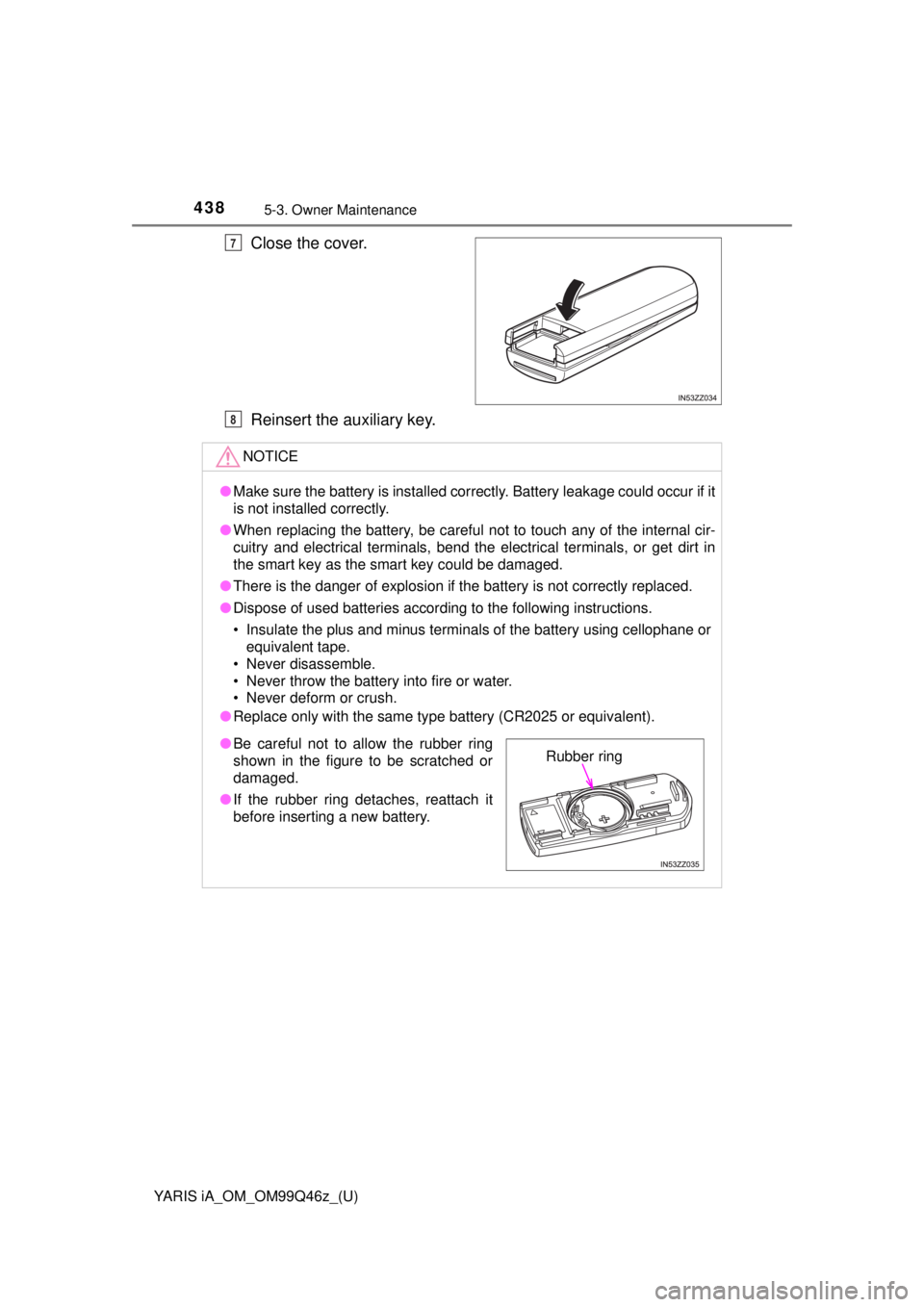
4385-3. Owner Maintenance
YARIS iA_OM_OM99Q46z_(U)
Close the cover.
Reinsert the auxiliary key.7
NOTICE
●Make sure the battery is installed correctly. Battery leakage could occur if it
is not installed correctly.
● When replacing the battery, be careful not to touch any of the internal cir-
cuitry and electrical terminals, bend the electrical terminals, or get dirt in
the smart key as the smart key could be damaged.
● There is the danger of explosion if the battery is not correctly replaced.
● Dispose of used batteries according to the following instructions.
• Insulate the plus and minus terminals of the battery using cellophane or
equivalent tape.
• Never disassemble.
• Never throw the battery into fire or water.
• Never deform or crush.
● Replace only with the same type battery (CR2025 or equivalent).
8
●Be careful not to allow the rubber ring
shown in the figure to be scratched or
damaged.
● If the rubber ring detaches, reattach it
before inserting a new battery.Rubber ring
Page 439 of 576
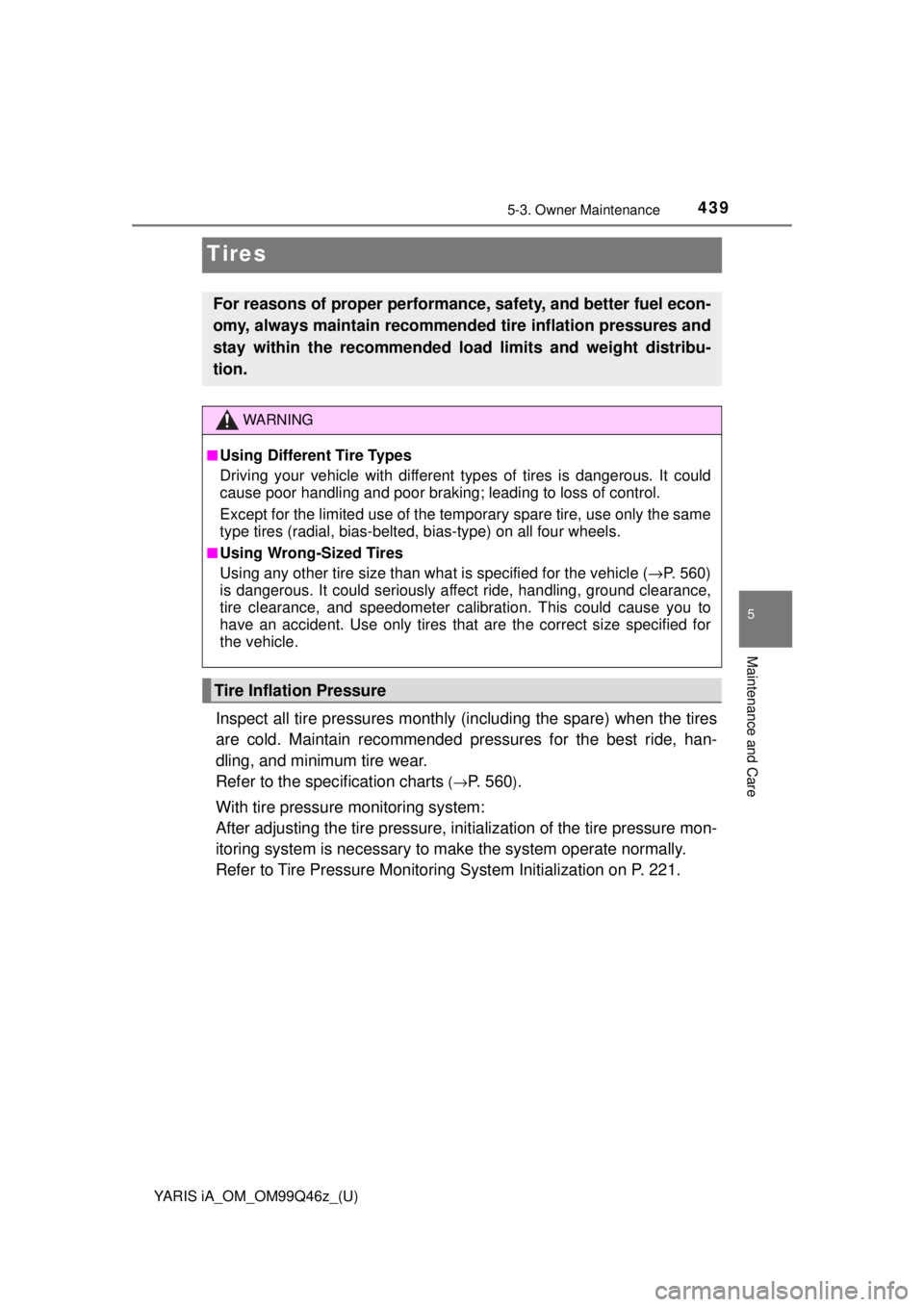
439
YARIS iA_OM_OM99Q46z_(U)
5-3. Owner Maintenance
5
Maintenance and Care
Tires
Inspect all tire pressures monthly (including the spare) when the tires
are cold. Maintain recommended pressures for the best ride, han-
dling, and minimum tire wear.
Refer to the spec ification charts
(→P. 5 6 0).
With tire pressure monitoring system:
After adjusting the tire pressure, init ialization of the tire pressure mon-
itoring system is necessary to make the system operate normally.
Refer to Tire Pressure Monitoring System Initialization on P. 221.
For reasons of proper performance, safety, and better fuel econ-
omy, always maintain recommended tire inflation pressures and
stay within the recommended load limits and weight distribu-
tion.
WARNING
■Using Different Tire Types
Driving your vehicle with different ty pes of tires is dangerous. It could
cause poor handling and poor braking; leading to loss of control.
Except for the limited use of the temporary spare tire, use only the same
type tires (radial, bias-belted, bias-type) on all four wheels.
■Using Wrong-Sized Tires
Using any other tire size than what is specified for the vehicle (→P. 560)
is dangerous. It could seriously affect ride, handling, ground clearance,
tire clearance, and speedometer ca libration. This could cause you to
have an accident. Use only tires that are the correct size specified for
the vehicle.
Tire Inflation Pressure
Page 440 of 576
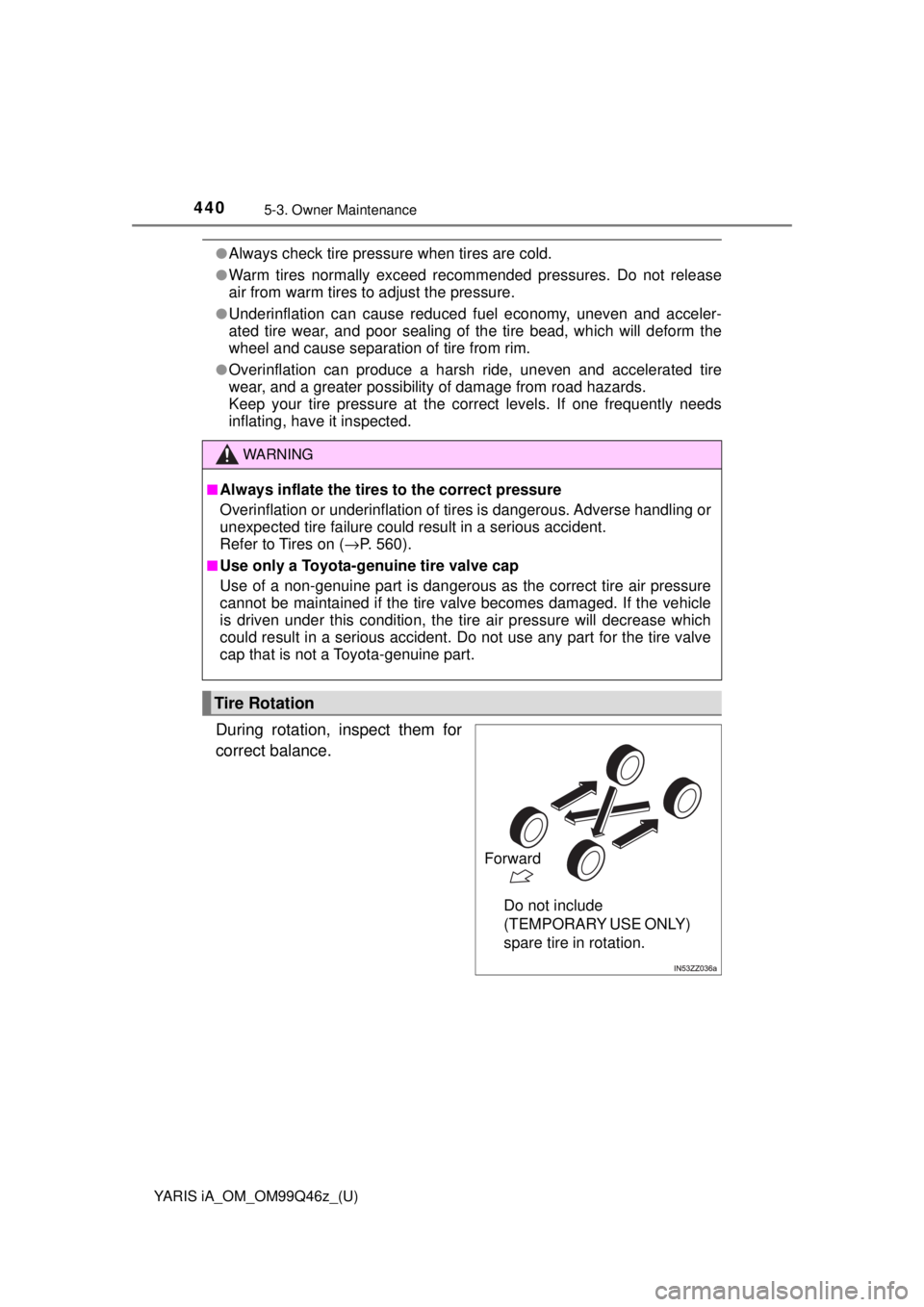
4405-3. Owner Maintenance
YARIS iA_OM_OM99Q46z_(U)
●Always check tire pressure when tires are cold.
●Warm tires normally exceed recommended pressures. Do not release
air from warm tires to adjust the pressure.
●Underinflation can cause reduced fuel economy, uneven and acceler-
ated tire wear, and poor sealing of the tire bead, which will deform the
wheel and cause separation of tire from rim.
●Overinflation can produce a harsh ride, uneven and accelerated tire
wear, and a greater po ssibility of damage from road hazards.
Keep your tire pressure at the correct levels. If one frequently needs
inflating, have it inspected.
During rotation, inspect them for
correct balance.
WARNING
■Always inflate the tires to the correct pressure
Overinflation or underinflation of tires is dangerous. Adverse handling or
unexpected tire failure could re sult in a serious accident.
Refer to Tires on ( →P. 560).
■Use only a Toyota-genuine tire valve cap
Use of a non-genuine part is danger ous as the correct tire air pressure
cannot be maintained if the tire valv e becomes damaged. If the vehicle
is driven under this c ondition, the tire air pr essure will decrease which
could result in a serious accident. Do not use any part for the tire valve
cap that is not a Toyota-genuine part.
Tire Rotation
Forward
Do not include
(TEMPORARY USE ONLY)
spare tire in rotation.
Page 441 of 576

YARIS iA_OM_OM99Q46z_(U)
4415-3. Owner Maintenance
5
Maintenance and Care
Also, inspect them for uneven wear and damage. Abnormal wear is
usually caused by one or a combination of the following:• Incorrect tire pressure
• Improper wheel alignment
• Out-of-balance wheel
• Severe braking
After rotation, inflate all tire pressures to specification (
→P. 560) and
inspect the lug nu ts for tightness.
With tire pressure monitoring system:
After adjusting the tire pressure, init ialization of the tire pressure mon-
itoring system is necessary to make the system operate normally.
Refer to Tire Pressure Monitoring System Initialization on P. 221.
WARNING
■Rotate tires periodically
Irregular tire wear is dangerous. To equalize tire wear and extend tire
life, Toyota recommends that tire rotation is carried out at the same
interval as tire inspection.
For scheduled maintenance information, please refer to the “Owner’s
Manual Supplement/Scheduled Maintenance Guide”.
NOTICE
Rotate unidirectional tires and radial tires that have an asymmetrical
tread pattern or studs only from front to rear, not from side to side. Tire
performance will be reduced if rotated from side to side.
Page 442 of 576
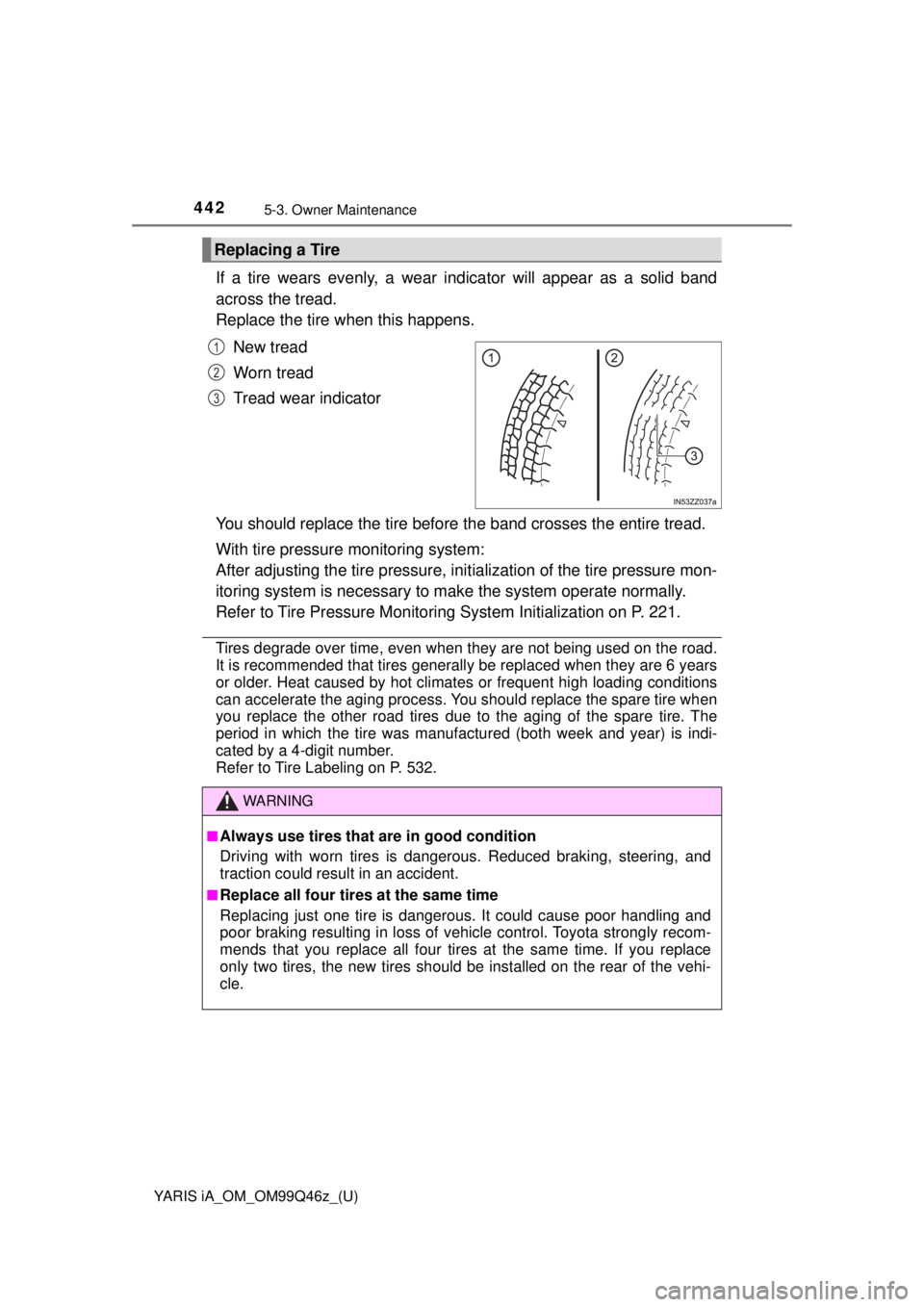
4425-3. Owner Maintenance
YARIS iA_OM_OM99Q46z_(U)
If a tire wears evenly, a wear indicator will appear as a solid band
across the tread.
Replace the tire when this happens.New tread
Worn tread
Tread wear indicator
You should replace the tire before the band crosses the entire tread.
With tire pressure monitoring system:
After adjusting the tire pressure, init ialization of the tire pressure mon-
itoring system is necessary to make the system operate normally.
Refer to Tire Pressure Monitoring System Initialization on P. 221.
Tires degrade over time, even when they are not being used on the road.
It is recommended that tires generally be replaced when they are 6 years
or older. Heat caused by hot climates or frequent high loading conditions
can accelerate the aging process. You should replace the spare tire when
you replace the other road tires due to the aging of the spare tire. The
period in which the tire was manufactured (both week and year) is indi-
cated by a 4-digit number.
Refer to Tire Labeling on P. 532.
Replacing a Tire
1
2
3
WARNING
■Always use tires that are in good condition
Driving with worn tires is dangerous. Reduced braking, steering, and
traction could result in an accident.
■Replace all four tires at the same time
Replacing just one tire is dangerous. It could cause poor handling and
poor braking resulting in loss of vehi cle control. Toyota strongly recom-
mends that you replace all four tires at the same time. If you replace
only two tires, the new tires should be installed on the rear of the vehi-
cle.